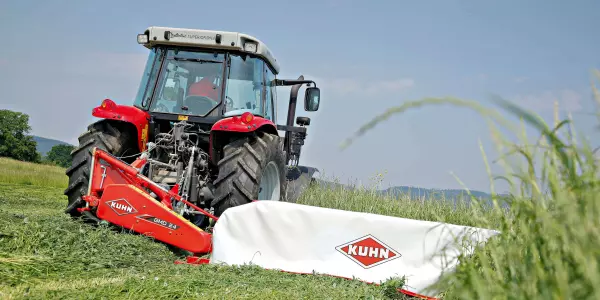What is a Disc Mower?
A disc mower is a type of agricultural machinery used to harvest hay, grass, and other forage. It uses a series of rotating blades or discs, which are mounted on a horizontal bar known as a cutterbar, to cut the crop close to the ground. The cutterbar is mounted onto a frame that is either mounted on a tractor or pulled behind it. The discs rotate at high speeds, slicing through the crop as the mower is pulled by the tractor. The cut crop is then deposited onto the ground in windrows, where it can be further processed or baled for storage or transport. Disc mowers are available in various sizes and configurations to suit different types of crops and field conditions. They are used in agriculture around the world due to their efficiency, versatility, and ease of use.
How Does a Disc Mower Work?
Here's how a disc mower works:
- Rotating Discs: The key components of a disc mower are the rotating discs, which are mounted on a horizontal cutterbar. These discs spin rapidly when the mower is in operation.
- Sharp Cutting Blades: Each disc is equipped with several sharp cutting blades. These blades are positioned parallel to the ground and rotate with the disc. As the discs spin, the blades create a scissoring action, cutting through the standing crop.
- Adjustable Height: Disc mowers usually have an adjustable cutting height, allowing farmers to control how close to the ground the mower cuts. This feature is essential for different types of crops and varying field conditions.
- Conditioning (Optional): Some disc mowers come with conditioning rollers or fingers placed behind the cutting discs. These rollers or flails can crimp or crush the cut forage, which can speed up the drying process, making the forage more suitable for baling or ensiling. For more about KUHN disc mower conditioners, click here.
- Windrow Formation: After cutting, the mower leaves the cut forage on the field in a windrow (a row of cut material). The width of the windrow can often be adjusted to suit the needs of the farmer or the equipment used for further processing (such as balers).
- Maintenance: Regular maintenance, including sharpening or replacing blades, lubricating moving parts, and checking the overall condition of the mower, is essential to ensure optimal performance and longevity of the equipment.
What are the advantages of a disc mower?
There are several advantages of using a disc mower for harvesting crops, including:
- High Efficiency: Disc mowers are highly efficient and can cover a large area quickly. They are ideal for farmers who need to harvest large quantities of hay or grass in a short amount of time.
- Uniform Cutting: Disc mowers are designed to provide a uniform cut, which helps to improve the quality of the harvested crop. The cutting discs are positioned in a row, and their rotating motion ensures that the crop is cut evenly.
- Versatility: Disc mowers can be used to harvest a variety of crops, including hay, grass, and other forages. They can also be used in different terrains and conditions, making them versatile machines.
- Reduced Crop Loss: Disc mowers are designed to cut cleanly, which reduces the amount of crop loss that can occur during harvesting.
- Lower Maintenance: Disc mowers are generally easy to maintain, with fewer moving parts compared to some other harvesting machinery. This means less time and money spent on maintenance and repair costs.
Overall, disc mowers are a popular choice for farmers who need to harvest crops efficiently and effectively.
Types of disc mowers and best disc mower for me?
There are several types of disc mowers available on the market, with varying features and capabilities. Here are four of the most common types:
Mounted disc mowers: These mowers are attached to the side or rear of a tractor and are designed for mowing hay or other crops. They can be either side-mounted or rear-mounted and typically have a lower profile than other types of disc mowers, which makes them better suited to uneven or rocky terrain.
Trailed disc mowers: These mowers are towed behind a tractor and are designed for use in large fields or when mowing multiple fields in a row. They can be quite large, and typically have a high capacity cutting system to handle large volumes of crop. What configuration best fits your operation side-pull or center-pivot disc mower? Side-pull disc mowers are ideal for customers looking for an economic and simplistic machine. Center-pivot machines are ideal for farmers looking for versatility which allows them to be able to mow on each side of the tractor vs side-pull mowers that can mow to only one side. The center-pivot disc mowers also excel at maneuvering through tight areas.
Triple mowers: These are disc mowers that have three cutting units and are designed to create a wider windrow with each pass. They are ideal for large farms or custom operators with high volumes of hay or other crops.












